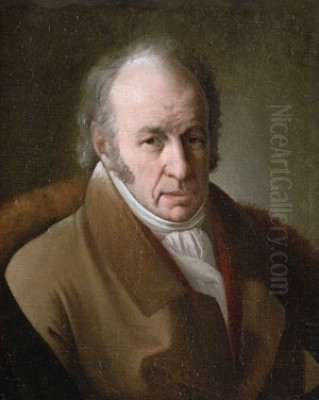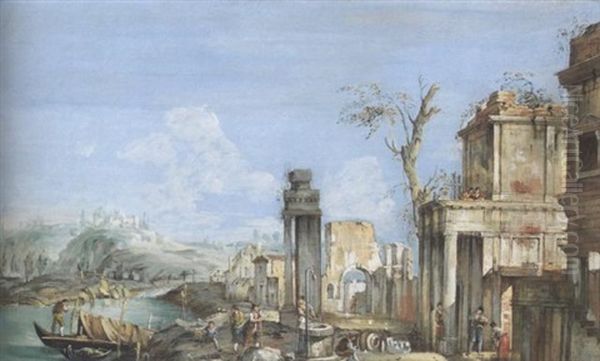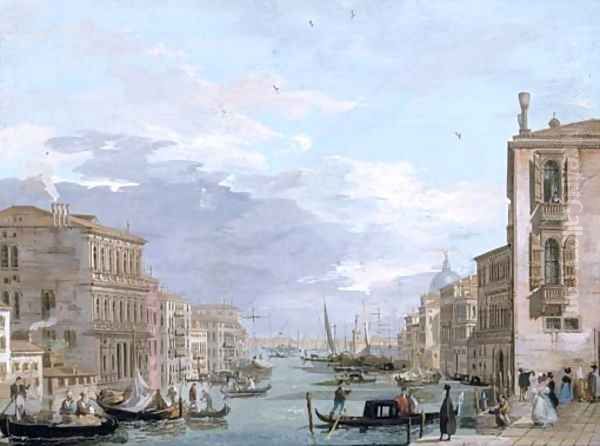
Giuseppe Bernardino Bison stands as a fascinating and prolific figure in Italian art, bridging the late Baroque and Rococo traditions of 18th-century Venice with the emerging sensibilities of Neoclassicism and early Romanticism. Active primarily as a painter of landscapes (vedute), historical and religious scenes, and as a highly sought-after decorative artist and stage designer, Bison's long career reflects the complex artistic and cultural shifts occurring in Northern Italy from the twilight of the Venetian Republic through the Napoleonic era and into the Austrian restoration. Though perhaps less universally renowned than some of his direct influences, his work offers a unique blend of technical skill, atmospheric sensitivity, and decorative flair.
Early Life and Venetian Formation
Born on June 16, 1762, in the fortified town of Palmanova in the Friuli region, then part of the Republic of Venice, Giuseppe Bernardino Bison's artistic journey began not in his birthplace but in Brescia, where his family relocated. It was in Brescia that he likely received his initial artistic training. However, the lure of Venice, the undisputed artistic capital of the region, soon drew him. He moved to Venice to further his education, enrolling in the prestigious Accademia di Belle Arti di Venezia (Venice Academy of Fine Arts) around 1779.
His time at the Accademia, extending until approximately 1789, was crucial. Here, he immersed himself in the dominant artistic currents and absorbed the lessons of the great Venetian masters. The towering figures of the recent past, whose influence still permeated the city's artistic atmosphere, were inescapable. The luminous, airy compositions of Giovanni Battista Tiepolo, arguably the last great decorative painter of the Venetian School, left a distinct mark on Bison's sense of light and colour, particularly in his decorative work. The legacy of Tiepolo, carried on by his sons, notably Giandomenico Tiepolo, provided a model for large-scale, elegant compositions.

Equally significant was the impact of the veduta painters. While Canaletto (Giovanni Antonio Canal) had passed away in 1768, his meticulously detailed and topographically accurate views of Venice set a standard for the genre. Bison, however, seems to have gravitated more towards the style of Francesco Guardi. Guardi, who died in 1793, captured Venice with a more atmospheric, suggestive, and flickering touch, emphasizing light, water, and the ephemeral quality of the city. Bison adopted this looser, more painterly approach in many of his own vedute, focusing on capturing the mood and spirit of a place rather than just its precise architectural form. The influence of earlier landscape and capriccio painters like Marco Ricci, known for his romantic landscapes and ruins, also likely played a role in shaping Bison's diverse interests.
During his formative years in Venice, Bison began collaborating with the prominent Neoclassical architect Antonio Selva. This partnership proved fruitful, leading to commissions for decorative schemes in palaces, villas, and churches throughout the Veneto region. Working alongside Selva, Bison honed his skills in large-scale decorative painting, often employing the traditional tempera technique for frescoes and wall panels. These early collaborations helped establish his reputation as a versatile artist capable of working within architectural contexts.
The Veduta Painter: Capturing Venice and Beyond
While Bison was a multifaceted artist, his reputation rests significantly on his work as a veduta painter. He operated within a well-established tradition, following in the footsteps of masters like Canaletto, Bernardo Bellotto (Canaletto's nephew, who worked extensively outside Venice), Michele Marieschi, and his more immediate influence, Francesco Guardi. Bison's Venetian views depict the iconic landmarks – St. Mark's Square, the Doge's Palace, the Grand Canal, the Rialto Bridge, Santa Maria della Salute – but often with a sensibility distinct from the crystalline precision of Canaletto.
Bison frequently favoured atmosphere over strict topographical accuracy. His Venetian scenes often possess a softer focus, emphasizing the play of light on water, the bustle of figures rendered with quick, calligraphic strokes, and the overall ambiance of the city. He was adept at capturing different times of day and weather conditions, from bright sunlight casting sharp shadows to the hazy light of dawn or the dramatic skies of an impending storm. This focus on atmospheric effects aligns him more closely with Guardi and anticipates elements of Romanticism. His figures, though small, are lively and effectively convey the human activity within the urban landscape.
His vedute were not limited to Venice. As he travelled and worked in other cities, he applied his skills to depicting their landmarks and environs. His views of Trieste, where he spent a significant period, are particularly noteworthy. He captured the city's harbour, its squares, and its surrounding landscapes, documenting its appearance during a period of growth and change under Austrian rule. These works serve as valuable historical records as well as accomplished artistic creations.

Bison's output in this genre was prolific, encompassing oil paintings, gouaches, and numerous drawings. His drawings, often executed in pen and ink with wash, reveal his quick, confident hand and his ability to capture the essence of a scene with economy and flair. These works were popular with collectors and tourists, continuing the tradition of vedute as desirable souvenirs and records of the Grand Tour, even as the nature of travel and patronage began to shift at the turn of the century.
Travels, Commissions, and Decorative Schemes
Bison's career was not confined to Venice. His talents were in demand across Northern Italy and neighbouring regions. After his initial period in Venice, he worked in Ferrara, known for its Este legacy, and Treviso, another important city within the Venetian mainland territories (Terraferma). His most significant period outside Venice, however, was spent in Trieste, a bustling port city under Austrian administration. He resided there from approximately 1800 to 1831.
In Trieste, Bison received major commissions, solidifying his reputation. Perhaps the most important was the decoration of the Palazzo Carciotti, a grand Neoclassical building overlooking the harbour. Working again in collaboration with the architect Matteo Pertsch (a student of Antonio Selva's contemporary, Giuseppe Piermarini), Bison contributed decorative elements that complemented the building's architecture. His work in Trieste extended to other palaces and public buildings, as well as easel paintings depicting the city and its surroundings.
His versatility extended to easel paintings beyond pure vedute. He painted historical scenes, mythological subjects, and genre scenes, often imbued with a sense of theatricality derived from his stage design work. These works showcase his narrative skills and his ability to handle complex figure compositions, often drawing inspiration from the rich visual vocabulary of Venetian painting history, including artists like Paolo Veronese or Jacopo Tintoretto, albeit translated into his later style.
The demand for decorative painting remained strong throughout his career. He adorned numerous villas and palaces with frescoes, tempera panels, and canvases featuring landscapes, allegorical figures, and ornamental motifs. His style in these decorative works often retained a lightness and elegance derived from the Rococo tradition of Tiepolo, even as Neoclassical tastes became more dominant. He skillfully adapted his style to suit the specific architectural context and the preferences of his patrons, demonstrating remarkable adaptability.
Master of Stage Design
Parallel to his work as a painter and decorator, Giuseppe Bernardino Bison was a highly accomplished and sought-after stage designer (scenografo). This aspect of his career was significant, linking him directly to the vibrant theatrical life of cities like Venice, Trieste, and later Milan. He designed sets for numerous operas and plays, contributing to the visual spectacle that was integral to the theatrical experience of the era.
His stage designs were known for their inventiveness, dramatic impact, and technical skill. He created elaborate architectural settings, romantic landscapes, and fantastical scenes, employing techniques of perspective and lighting to create convincing illusions on stage. His experience as a veduta and capriccio painter clearly informed his stage designs, allowing him to create compelling spatial environments. He worked for major theatres, including the renowned Teatro La Fenice in Venice, the Teatro Grande in Trieste, the theatre in Gorizia, and later, potentially, the Teatro alla Scala in Milan, though his precise involvement there requires careful documentation.
Designing for the stage required not only artistic skill but also an understanding of dramatic narrative and the technical requirements of theatre production. Bison excelled in creating atmospheres appropriate to the opera or play being performed, whether it was a grand historical tragedy, a lighthearted comedy, or a romantic opera. His designs often featured dramatic architectural elements, picturesque ruins (a popular motif in both painting and stage design of the period, linking him to artists like Giovanni Paolo Panini or the French Hubert Robert), and atmospheric landscapes. This work undoubtedly influenced his easel painting, infusing it with a certain theatricality and sense of composition.
Diverse Genres: Religious Paintings and Capricci
While best known for landscapes and decorative work, Bison also engaged with religious themes. He painted altarpieces and devotional works for churches and private patrons. Examples like The Martyrdom of St. Andrew demonstrate his ability to handle traditional religious subjects. However, contemporary and later critical assessments of his religious output have sometimes been mixed. Some sources mention criticisms suggesting these works were not always considered his strongest, perhaps lacking the devotional intensity or compositional grandeur expected in major religious commissions compared to specialists in the field.
Nevertheless, his religious paintings form a part of his diverse oeuvre, showcasing his engagement with the full range of subjects expected of a successful artist of his time. They often display his characteristic attention to detail and competent handling of figures, even if they did not always achieve the same level of acclaim as his landscapes or decorative schemes.
More consistently popular and critically appreciated were his capricci. These architectural fantasies, often featuring classical ruins, imaginary landscapes, and small, lively figures, allowed Bison greater freedom of invention than the topographically bound veduta. He excelled in this genre, creating charming and picturesque scenes that combined elements of real and imagined architecture in evocative settings. These works tapped into the Neoclassical fascination with antiquity and the Romantic sensibility for the picturesque and the sublime, often associated with ruins and the passage of time. His capricci, like his vedute, were produced in various media, including oils, gouaches, and numerous drawings, finding a ready market among collectors.
Artistic Style: Bridging Eras
Giuseppe Bernardino Bison's style is complex and reflects his position straddling different artistic movements. His foundations lie firmly in the 18th-century Venetian tradition. The painterly handling, atmospheric light, and decorative elegance seen in the works of Tiepolo and Guardi are evident throughout his career. He inherited their facility with brushwork, their understanding of colour harmonies, and their ability to create light-filled spaces.
However, Bison was also working during the ascendancy of Neoclassicism. While not a purely Neoclassical painter in the mould of, say, Andrea Appiani in Milan or Jacques-Louis David in France, Bison absorbed elements of the style. This can be seen in the clarity of composition found in some of his works, his interest in classical architecture (both real and imagined in his capricci), and a certain restraint that sometimes tempers the Rococo exuberance of his influences. His collaboration with Neoclassical architects like Selva also placed him directly within this aesthetic current.
Furthermore, elements of early Romanticism pervade his work, particularly his landscapes and capricci. The emphasis on atmosphere, the interest in the picturesque and the sublime (especially in scenes with ruins or dramatic weather), and the slightly melancholic or nostalgic mood that sometimes infuses his views of Venice align him with emerging Romantic sensibilities. He captured not just the look of a place, but its emotional resonance.
Technically, Bison was highly proficient across various media. He was a skilled oil painter, capable of both detailed finishes and looser, more suggestive brushwork. He was particularly adept with tempera, especially for large-scale decorative work, and gouache, a medium well-suited to capturing luminous effects in smaller vedute and capricci. His prolific output as a draughtsman, using pen, ink, and wash, underscores his technical facility and the importance of drawing in his creative process. His drawings often possess a remarkable spontaneity and vibrancy.
Later Years in Milan
Around 1831, perhaps seeking new opportunities or patronage as Trieste's importance potentially shifted, Bison moved to Milan. Milan, under Austrian rule after the Napoleonic period, was a significant administrative and cultural centre. Here, he continued to work, though details of his Milanese period are perhaps less documented than his time in Venice or Trieste. He likely continued to paint landscapes, vedute (perhaps of Milanese scenes or nostalgic views of Venice), and potentially undertook decorative or stage design commissions.
Despite his considerable output and earlier success, sources suggest his final years may have been marked by financial difficulties. The changing tastes and patronage systems of the 19th century might have impacted the demand for his particular blend of styles. He died in Milan on August 25, 1844, bringing to a close a long and productive career that spanned dramatic changes in the political and artistic landscape of Italy.
Contemporaries and Context
Understanding Bison requires placing him within the rich artistic context of his time. He worked alongside and was aware of numerous other artists. In Venice, besides his key influences (Tiepolo family, Guardi, Canaletto, Ricci), he would have known the work of genre painters like Pietro Longhi, whose depictions of Venetian life offered a different perspective, and other landscape painters like Francesco Zuccarelli or Giuseppe Zais, who focused more on idyllic, pastoral scenes. Giacomo Guardi, Francesco's son, continued the veduta tradition in a manner often close to his father's. The legacy of earlier vedutisti like Luca Carlevaris was also part of the background.
His collaboration with Antonio Selva places him amidst the leading Neoclassical architects. In Trieste, he would have encountered artists catering to the tastes of the Austrian administration and the city's mercantile elite. In Milan, he arrived in a city where Neoclassicism had been strongly established by figures like the architect Giuseppe Piermarini and the painter Andrea Appiani, and where the dominant artistic figure was perhaps the sculptor Antonio Canova (though Canova was based primarily in Rome, his influence was pan-Italian). Bison navigated these currents, maintaining his own distinct artistic identity while adapting to prevailing tastes.
The historical context is also crucial. Bison lived through the decline and fall of the Venetian Republic (1797), the turmoil of the Napoleonic Wars, the establishment of French-controlled kingdoms in Italy, and the subsequent restoration of Austrian power in Lombardy-Venetia and Trieste. These political shifts impacted patronage, artistic institutions, and the very fabric of the cities he depicted. His career reflects a resilience and adaptability in the face of these changes.
Legacy and Rediscovery
During his lifetime, Giuseppe Bernardino Bison achieved considerable success as a decorative artist, stage designer, and painter, particularly of vedute and capricci. However, he did not perhaps attain the lasting international fame of Canaletto or the critical reverence accorded to Tiepolo during the subsequent centuries. For a period after his death, his name might have been somewhat overshadowed.
His rediscovery and re-evaluation began in the late 19th and, more significantly, the early 20th century. Exhibitions, such as the "Antichità Caiati" show mentioned in 1942, helped bring his work back into focus. Art historians and collectors began to appreciate his unique position as a transitional figure, his technical skill, and the charm and atmospheric quality of his paintings and drawings. He came to be recognized as one of the last significant exponents of the Venetian veduta tradition, carrying it forward into the early 19th century while infusing it with new stylistic nuances.
Today, Bison's works are held in numerous important museums and private collections across Italy and internationally. Major holdings can be found in the Museo Revoltella and the Fondazione Scaramangà in Trieste (reflecting his long activity there), the Gallerie dell'Accademia in Venice, the Civici Musei (including the Sforza Castle museums) in Milan, the Uffizi Gallery in Florence, as well as institutions like the Metropolitan Museum of Art in New York and the Courtauld Gallery in London.
His legacy lies in his prolific output, his versatility across genres and media, and his sensitive capturing of the landscapes and cityscapes of his time. He represents a vital link between the great Venetian tradition of the 18th century and the art of the 19th century, blending Rococo grace, Neoclassical structure, and Romantic atmosphere in a unique and appealing manner. His decorative work and stage designs also highlight the interconnectedness of the arts during his era.
Conclusion
Giuseppe Bernardino Bison was an artist of remarkable industry and adaptability. Born into the world of the Venetian Republic, his career unfolded against a backdrop of profound political and cultural change. He absorbed the lessons of the great 18th-century Venetian masters like Tiepolo and Guardi, yet forged his own path, creating works that responded to the emerging tastes for Neoclassicism and Romanticism. As a painter of vedute, capricci, historical and religious scenes, and as a sought-after decorator and stage designer, he left an indelible mark on the artistic landscape of Northern Italy. While perhaps navigating the space between more famous names, his skillful technique, atmospheric sensitivity, and sheer versatility ensure his place as a significant and engaging figure in the transition from the splendours of the Venetian Rococo to the complexities of 19th-century art. His works continue to charm viewers with their depictions of iconic cities, imaginative scenes, and masterful handling of light and colour.